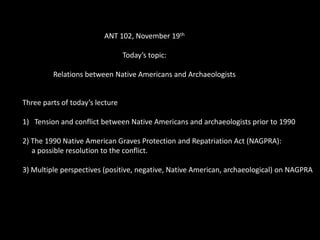
Wk 14 nov 19 kennewick and nagpra
- 1. ANT 102, November 19th Today’s topic: Relations between Native Americans and Archaeologists Three parts of today’s lecture 1) Tension and conflict between Native Americans and archaeologists prior to 1990 2) The 1990 Native American Graves Protection and Repatriation Act (NAGPRA): a possible resolution to the conflict. 3) Multiple perspectives (positive, negative, Native American, archaeological) on NAGPRA
- 2. 1) Tension and conflict between Native Americans and archaeologists prior to 1990 Native American disagreements with archaeologists --Ways of knowing the past --Desecration of graves
- 3. Kodiak Island Ales Hrdlicka American Museum of Natural History
- 4. American Indian Movement (AIM) occupation of Alcatraz Island, San Francisco Bay Vine Deloria, Jr.
- 5. American Indian Movement (AIM) occupation of Wounded Knee
- 6. NAGPRA: Native American Graves Protection and Repatriation Act (1990) Senator John McCain: “I believe this bill represents a true compromise…In the end, each party had to give a little in order to strike a balance and to resolve these very difficult emotional issues…I believe this legislation effectively balances the interest of Native Americans in the rightful and respectful return of their ancient ancestors with the interests of our nation’s museums in maintaining our rich cultural heritage, the heritage of all American peoples.” NAGPRA does two things for Native Americans 1) Protects Graves 2) Repatriates (returns) bones and sacred objects to tribes
- 7. 1) Graves protection --Any archaeology project on federal land or using federal funding must consult with the nearest native American tribe if any Native American ruins are to be studied --If graves are found on such a project, Native Americans determine what to do.
- 8. 2) Repatriation Step 1: museums inventory their collections, studying all Native American bones and sacred objects Step 2: museums inform tribes of the Native American bones and sacred objects in their collections. Step 3: A Native American tribe requests that bones or objects be repatriated.
- 9. Pecos pueblo, occupied 1000 AD, abandoned 1838 AD
- 11. 2) Repatriation Step 1: museums inventory their collections, studying all Native American bones and sacred objects Step 2: museums inform tribes of the Native American bones and sacred objects in their collections. Step 3: A Native American tribe requests that bones or objects be repatriated. Step 4: If necessary, the request goes to court to decide if there is cultural affiliation between the tribe and the bones and/or objects. What determines cultural affiliation? preponderance of evidence (51%) What counts as evidence? Archaeology, genetics, skeletal biology, written history, oral history, language, geography. What evidence is given the most weight? All forms of evidence carry equal weight Example of a questionable case of cultural affiliation: Kennewick Man
- 12. Shore of Columbia River where Kennewick man was found stock photo of two college students Forensics expert’s Skull of Representation of Kennewick Man/ Kennewick Man/ The Ancient One The Ancient One James Chatters (coroner/archaeologist)
- 13. Bonnichsen (and others) vs. The United States Douglas Minthorn, Umatilla Tribe Bonnichsen Chatters Neo-pagans of European descent who wanted the skeleton for themselves
- 14. 2) Repatriation Step 1: museums inventory their collections, studying all Native American bones and sacred objects Step 2: museums inform tribes of the Native American bones and sacred objects in their collections. Step 3: A Native American tribe requests that bones or objects be repatriated. Step 4: If necessary, the request goes to court to decide if there is cultural affiliation between the tribe and the bones and/or objects. What determines cultural affiliation? preponderance of evidence (51%) What counts as evidence? Archaeology, genetics, skeletal biology, written history, oral history, language, geography. What evidence is given the most weight? All forms of evidence carry equal weight Step 5: Once cultural affiliation is demonstrated, the tribe gets their stuff back from the museum. Are all affiliated remains always returned to the tribe? NO NAGPRA as civil rights legislation
- 15. As McCain said, NAGPRA strikes a balance between Native Americans and archaeologists Nobody is completely happy Why would Native Americans be unhappy? 1) NAGPRA only covers skeletons found on federal land 2) Museums are allowed to study human remains before repatriation 3) Very old remains (>1000 years) are usually not covered by NAGPRA 4) Archaeological evidence often does trump other forms of evidence when discussing debating cultural affiliation 5) Only federally recognized tribes qualify for repatriation under NAGPRA
- 16. As McCain said, NAGPRA strikes a balance between Native Americans and archaeologists Nobody is completely happy Why would Archaeologists be unhappy? 1) Archaeologists think that their possession of Native American objects has helped Native Americans and could continue to help them. 2) NAGPRA permits destruction of evidence 3) NAGPRA elevates native American religious beliefs above the principals of science 4) Cultures change : how can a “Navajo” from 500 years ago be affiliated with a Navajo today?
- 17. As McCain said, NAGPRA strikes a balance between Native Americans and archaeologists Nobody is completely happy Why would Archaeologists be unhappy? 1) Archaeologists think that their possession of Native American objects has helped Native Americans and could continue to help them. 2) NAGPRA permits destruction of evidence 3) NAGPRA elevates native American religious beliefs above the principals of science 4) Cultures change : how can a “Navajo” from 500 years ago be affiliated with a Navajo today? NAGPRA is not all bad for archaeology. 1) Most skeletal remains are unaffiliated 2) Museums are now forced to catalog and study their skeletons 3) Newly excavated skeletons will receive much better study 4) Curation facilities have improved 5) NAGPRA makes archaeologists more ethical: it is a good thing for archaeologists to respect civil rights of Native Americans
- 18. Are the two sides (archaeologists and native Americans) always so different? Dorothy Lippert, Choctaw Indian, Joe Watkins, Choctaw Indian, archaeologist employed by the Smithsonian. University of Oklahoma.